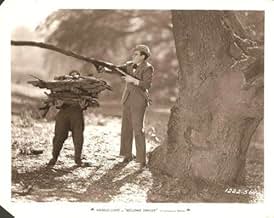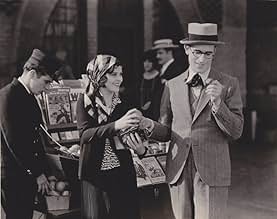Agrega una trama en tu idiomaHarold Bledsoe, a botany student, is called back home to San Francisco, where his late father had been police chief, to help investigate a crime wave in Chinatown.Harold Bledsoe, a botany student, is called back home to San Francisco, where his late father had been police chief, to help investigate a crime wave in Chinatown.Harold Bledsoe, a botany student, is called back home to San Francisco, where his late father had been police chief, to help investigate a crime wave in Chinatown.
- Dirección
- Guionistas
- Elenco
Charles Middleton
- John Thorne aka The Dragon
- (as Chas. Middleton)
Will Walling
- Police Captain Walton
- (as William Walling)
Grady Sutton
- Man at Party (silent version)
- (escenas eliminadas)
Brooks Benedict
- Handcuffed Prisoner at Police Station
- (sin créditos)
Eddy Chandler
- Cop
- (sin créditos)
Rae Daggett
- Woman Sitting in Police Station
- (sin créditos)
Douglas Haig
- Buddy Lee
- (sin créditos)
Edgar Kennedy
- SFPD Desk Sergeant
- (sin créditos)
Tetsu Komai
- Florist Henchman
- (sin créditos)
Wang Lee
- Chinaman with Queue
- (sin créditos)
James B. Leong
- Florist Henchman
- (sin créditos)
- …
Jim Mason
- Barry Steele
- (sin créditos)
- …
Nelson McDowell
- 1st Train Passenger
- (sin créditos)
Soo Hoo Sun
- Dead Chinese Man
- (sin créditos)
James Wang
- Dr. Chang Gow
- (sin créditos)
Opiniones destacadas
While one can admire Harold Lloyd's willingness to plunge into sound films, this effort is a huge letdown after the brilliance of his silent films, culminating in `Speedy.' Many of the gags go on WAY too long, and sound makes much of the slapstick more painful than funny. It may be that sound also contributes to making Lloyd's character extremely annoying, especially in the early reels. If that weren't enough, the dubbing process used in the scenes not reshot for sound is very primitive and distracting. Worth seeing for Lloyd fans, but not too funny.
How many bludgeonings can you have in a movie before it ceases to be funny? My five year old and I might disagree on this, but I think that Harold Lloyd crossed that subtle line in this movie. It started off cute and funny, but quickly became sadistic. Compared to Hot Water and Safety Last, this was a poor comedy; however, compared to the Three Stooges or The Ritz Brothers, it wasn't bad.
Maybe hitting several dozen Chinese immigrants in the head with a club was funnier back then...
Maybe hitting several dozen Chinese immigrants in the head with a club was funnier back then...
Harold Lloyd's first talkie is an uneasy transitional film between the silent and the sound era. It was originally made to be a silent, and it was re-written, and much of it was re-filmed in order to make it play. What would have been best for the movie would have been to cut out the fat. It goes on for far too long, just five minutes short of two hours, which must have been Lloyd's longest film. And I've read that the original cut was nearly three hours! I love Harold more than anybody, but two hours is a little too much. I couldn't even imagine a longer version. It is a pretty good comedy, though. There are a handful of brilliant comedy bits, and Harold Lloyd, more so than either Keaton or Chaplin, was just as good in his talkies as he was in his silents. There's also a lot of brutal slapstick. That was always a part of Lloyd's work, more than Keaton's or Chaplin's, but not even the Three Stooges are this violent! Harold must brain about thirty people. It is mostly funny I'll give him that credit but sometimes I had to give his enemies a sympathy `OUCH!' In the film's very funny finale, Lloyd fights a gigantic black man. To knock him out once and for all, Harold shoves his hand in one of those giant conch shells and clubs the guy on the head several times in a row. OUCH! 7/10.
Don't get me wrong, I love Harold Lloyd - both his talkies and silents. However, "Welcome Danger" was a real disappointment. It was Lloyd's first talking picture, started as a silent. When he finished he realized that sound had "arrived" and reshot it as a talking picture.
The awkwardness of the picture is no worse than any other early sound film, but the big problem is Harold's persona. As usual, he is the eager beaver trying to make good, but for some reason he makes his character out to be one of the most annoying personalities in film history. He is outright mean to people who really don't deserve it.
Lloyd plays Harold Bledsoe, a college student studying botany. His father is chief of police in San Francisco. After his father dies, Harold returns home to help the force with a crime wave in Chinatown. However, he becomes fascinated with fingerprint technology and soon has the department tied in knots with all of his cataloguing and fingerprinting. Soon the police department that welcomed him so heartily would do anything to get him out of their collective hair.
It is a shame this isn't on DVD because it is not THAT bad, and it is an important milestone in cinema history since it was Lloyd's very first talking picture. "Feet First" was his second talking effort, and a much better film too. One of the real treats of this film is an unbilled appearance by Edgar Kennedy as a desk sergeant in the San Francisco police department. He spends a long time on screen for him to have no credit whatsoever, but he does a wonderful job of playing the irascible beat cop we see in his later films.
The awkwardness of the picture is no worse than any other early sound film, but the big problem is Harold's persona. As usual, he is the eager beaver trying to make good, but for some reason he makes his character out to be one of the most annoying personalities in film history. He is outright mean to people who really don't deserve it.
Lloyd plays Harold Bledsoe, a college student studying botany. His father is chief of police in San Francisco. After his father dies, Harold returns home to help the force with a crime wave in Chinatown. However, he becomes fascinated with fingerprint technology and soon has the department tied in knots with all of his cataloguing and fingerprinting. Soon the police department that welcomed him so heartily would do anything to get him out of their collective hair.
It is a shame this isn't on DVD because it is not THAT bad, and it is an important milestone in cinema history since it was Lloyd's very first talking picture. "Feet First" was his second talking effort, and a much better film too. One of the real treats of this film is an unbilled appearance by Edgar Kennedy as a desk sergeant in the San Francisco police department. He spends a long time on screen for him to have no credit whatsoever, but he does a wonderful job of playing the irascible beat cop we see in his later films.
Harold Lloyd's first talkie is a take on the always popular genre of a seemingly buffoonish, and klutzy inspector who solves the big case while acting the fool. First of all, the movie works, basically. Secondly, it fails to heed the unwritten rule of comedy "Keep them wanting more". Every gag is funny the first time, the second time but the third, fourth and fifth... NO!!! Despite this, Lloyd is funny and symphathetic. But I must comment, something was lost when Lloyd went to sound. It's like hearing him talk took away some of his movie star magic, a little star dust faded astern. He also seems to be slumming it, more interested in keeping his fans and his star status than making genuine great comedies. That said, the side kick inspector is good, and the final twenty minutes though a bit draggy is very funny. I laughed a number of times through that sequence. And the final shot and line is what the silent Harold Lloyd comedies were all about. It's a pity we don't get more of that in this movie.
¿Sabías que…?
- TriviaBegan shooting as a silent in August, 1928 at Metropolitan Studios, it would become an agonizingly long and complicated production. It was finally released on October 12, 1929 as a talkie after largely being re-shot with another director - Clyde Bruckman as a talkie (marking the first time Lloyd worked from a script) and painstakingly edited down from an original 16-reels (some 2 hours and forty-five minutes) to 12-reels. The silent version cost $521,000 and another $281,000 was spent on the sound negative. While the novelty of hearing Lloyd speak made it his largest grossing hit since The Freshman (1925), those steep production costs resulted in a huge drop in net profits from his earlier features.
- ErroresAfter the dish washing scene ends between Harold and Billlie and the screen goes dark, CUT! can clearly be heard before the next scene begins.
- Citas
Billie Lee: I just put my foot in the wrong place.
Harold Bledsoe: Oh, you did. Well, if you do it again, I'll put my foot in the right place!
- Versiones alternativasThere is an all-silent version of this film distributed to unwired cinemas which includes more of the original "silent" version and is adapted with inter-titles for the newer sound sequences.
- ConexionesFeatured in American Masters: Harold Lloyd: The Third Genius (1989)
Selecciones populares
Inicia sesión para calificar y agrega a la lista de videos para obtener recomendaciones personalizadas
Detalles
Taquilla
- Presupuesto
- USD 979,828 (estimado)
- Tiempo de ejecución
- 1h 53min(113 min)
- Color
Contribuir a esta página
Sugiere una edición o agrega el contenido que falta






























